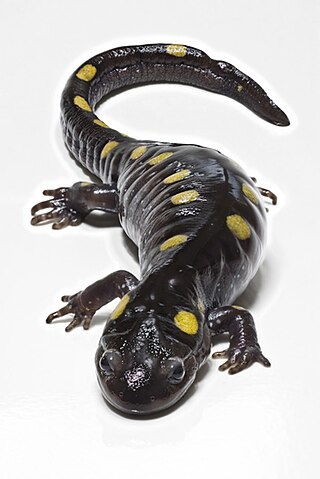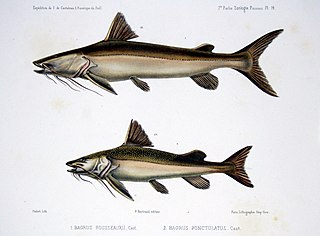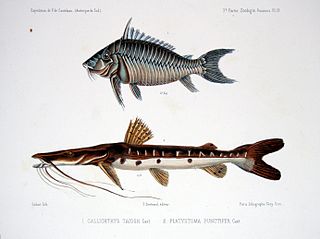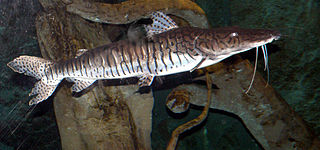
Lilium lancifolium is an Asian species of lily, native to China, Japan, Korea, and the Russian Far East. It is widely planted as an ornamental because of its showy orange-and-black flowers, and sporadically occurs as a garden escapee in North America, particularly the eastern United States including New England, and has made incursions into some southern states such as Georgia.

The mole salamanders are a group of advanced salamanders endemic to North America. The group has become famous due to the presence of the axolotl, widely used in research due to its paedomorphosis, and the tiger salamander which is the official amphibian of many US states, and often sold as a pet.

The tiger salamander is a species of mole salamander and one of the largest terrestrial salamanders in North America.

Pseudoplatystoma is a genus of several South American catfish species of family Pimelodidae. The species are known by a number of different common names. They typically inhabit major rivers where they prefer the main channels and tend to stay at maximum depth, but some species can also be seen in lakes, flooded forests, and other freshwater habitats. They have robust bodies, and are important food fish. Recently, their population size has been on the drastic decline due to a variety of factors including overfishing and habitat destruction due to the construction of hydroelectric dams.

The Pimelodidae, commonly known as the long-whiskered catfishes, are a family of catfishes.
Pintado means "painted" in Spanish and Portuguese and may refer to:

The redtail catfish, Phractocephalus hemioliopterus, is a pimelodid (long-whiskered) catfish. In Venezuela, it is known as cajaro, in Guyana, it is known as a banana catfish, and in Brazil, it is known as pirarara, stemming from the Tupi language words pirá and arara. It is the only extant species of the genus Phractocephalus. This fish is common in the aquarium trade, although its massive adult size makes it unsuitable for all but the largest aquariums. They feed on fish, crustaceans and fallen fruits. They are not evaluated by IUCN.

The barred tiger salamander or western tiger salamander is a species of mole salamander that lives in lower western Canada, the western United States and northern Mexico.

Brachyplatystoma is a genus of catfish from the family Pimelodidae. As the occasionally used common name goliath catfishes indicates, this genus includes some of the largest species of catfish, including the piraíba, B. filamentosum, which reaches up to the region of 3.6 metres (12 ft) in length. Brachyplatystoma are found in the Amazon and Orinoco basins, and other tropical freshwater and brackish habitats in South America. Some species are migratory. These fish are important as food fish and, to some extent, aquarium fish.

The porthole shovelnose catfish or spotted shovelnose catfish, Hemisorubim platyrhynchos, is the only species in the genus Hemisorubim of the catfish family Pimelodidae.
Plectrochilus is a genus of pencil catfishes native to South America.

Pseudoplatystoma fasciatum or barred sorubim or barred catfish is a species of long-whiskered catfish native to the Suriname, Corantijn and Essequibo. The nocturnal predator feeds mainly on other fish and crabs. Females reach a more notable size. They become sexually mature at 56 cm (22 in), males at 45 cm (18 in) and this species reaches a maximum length of 90 cm (35 in) TL. Fecundity seems to be estimated at 8 million eggs per kg, but was recently measured in aquaculture at a lower, and more likely number of 150,000 eggs laid per kg.
Dipteropeltis hirundo is a little-known species of fish louse. It is an ectoparasite of fish found in South America, including piranhas and barred sorubim.
Proteocephalidae is a diverse family tapeworms with nearly 300 recognized species in 66 genera and 13 subfamilies, whose species are found in every continent. They are mainly parasites of siluriforms and other freshwater fishes, but also parasitize reptiles and amphibians. A typical proteocephalid life cycles include planktonic crustaceans, and small fish as intermediate hosts.

Pseudoplatystoma punctifer or spotted tiger shovelnose catfish is a species of long-whiskered catfish native to the Amazon basin, in Bolivia, Brazil, Colombia, Ecuador, Peru, and Venezuela. It is a commercially farmed species, and it is difficult to harvest as it appears to be highly selective with its diet and exhibits cannibalistic behaviors. Other behaviors and developmental patterns vary based on both diet as well as parental behaviors that influence the organisms development from the Larval stage.

The barred sorubim is a species of long-whiskered catfish native to the Río de la Plata basin and Amazon basin in South America. It reaches up to about 60 cm (2.0 ft) in length.

The Paraná flooded savanna (NT0908) is an ecoregion that borders the southern Paraná River in Argentina. It has largely been converted to agriculture or occupied by urban development, but scattered patches of the original habitat remain along the river.
Brachyplatystoma tigrinum, the zebra shovelnose, or tigerstriped catfish, is a large species of catfish of the family Pimelodidae that is native to the Amazon basin in Brazil, Colombia and Peru. It is entirely piscivorous.

The Wonotobo Falls are a series of waterfalls in the Courantyne River in Sipaliwini District, Suriname near the border with Guyana. The waterfalls are not navigable. A pre-Columbian petroglyph site is located near the falls.














